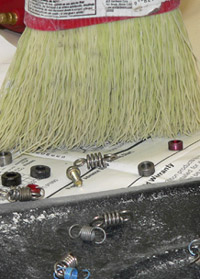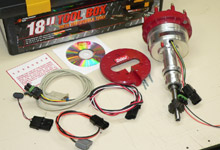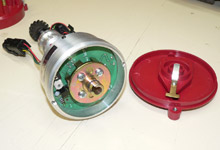|

by Jon Mikelonis
Introduction
Although a new car equipped with a mechanical advance distributor
hasn't rolled off the assembly line in more than 20 years,
the mechanism also known as the centrifugal advance, has remained
a tried and true method for controlling spark timing in all
varieties of Ford project cars running non-computer controlled
V8's. While nearly full-proof, centrifugal advance counts
on the proper functioning of several moving parts, is almost
always linear with RPM, and is awkward to tune with "small
part" kits that provide interchangeable color-coated
springs and stop bushings to get the job done. Regardless,
old habits die hard and until an early model enthusiast watches
a late model enthusiast plug in a fresh advance curve through
a tuner or laptop, traditionalists will never fully understand
how outdated mechanical advance assemblies really are. Until
recently, the point has been moot because if you're running
a carburetor then you're spark timing is controlled mechanically
by the distributor and if you've gone EFI then your spark
timing is controlled electronically through the vehicle's
computer. Simple as that, until now there were no options
to mechanical advance distributors for early carbureted V8's.
| |
 |
| The speed and control with which you
can change and tune your advance curve with an electronic
advance distributor allows you to sweep away aging centrifugal
advance parts. |
| |
Enter the development of the electronic
advance (EA) distributor. If you have not already discovered
them, Mallory, MSD, and Crane Cams have all released EA distributors
for early carbureted Ford V8's over the past few years.
If you are wondering what the big deal is about another electronic
ignition, let us make something clear, the "electronic"
in "electronic advance" isn't referring to the spark
trigger
method (ie, breaker, magnetic, or optical), it's referring
to the manner in which your spark ADVANCE is controlled. This
being said, EA distributors completely eliminate the need
for mechanical advance assemblies inside the distributor and
better yet, your vehicle DOES NOT need a computer to run one.
What this means to the early Ford enthusiast or for those
of you who remain "carburetor comfortable", is that
you can now ditch mechanical advance kits and begin programming
and experimenting with advance curves as fast and often as
your EFI counterparts.
 |
|
| The MSD Digital E-Curve and the Crane
Pro-Curve both use rotary dials that allow the user to
choose from a set of predetermined advance curves. |
|
Market Snapshot
The FordMuscle staff has been eager to get their hands
on an EA type distributor since Crane Cams introduced their
"Pro-Curve Billet" variety back in 2004. While that
never materialized, we're glad we waited because the market
has become more balanced now that MSD introduced their "Digital
E-Curve" and Mallory developed the "E-Fire"
and the "Max-Fire". While all four electronic advance
distributors are designed to target the same enthusiast profile
and early carbureted applications, there are differences among
them all.
The primary point of differentiation
between the current market of EA distributors is how the advance
curves are determined by the user. Mallory has taken the lead
in developing custom tuning software to accompany their Max-Fire
and E-Fire distributors while Crane Cams and MSD have integrated
rotary dials into the distributor itself and predetermined
the possible advance curve settings for the user. Crane Cams
uses external dials while MSD keeps them under the cap. See
image above left. While the dial type advance controls of
MSD and Crane Cams do not require a computer, they do not
allow the user to map their own custom advance curve. This
may or may not be a limitation depending on your desire to
experiment and personalize. After all, the MSD Digital E-Curve
provides almost 100 different advance curves and even Crane's
27 available curves will satisfy most enthusiasts. Keep in
mind, both Crane and MSD arrive at their total number of curves
by multiplying the number of "centrifugal" curves
by the number of vacuum advance curves.
Another important area of differentiation among EA distributors
is which units have a built-in ignition and which do not.
Both MSD's and Mallory's versions have ignitions under the
cap, eliminating the need for an external box. However, Mallory
is the first to have added a capacitive discharge (CDI) which
is available in the Max-Fire. The MSD Digital E-Curve and
the Mallory E-Fire also do not require an external box, however
their ignition's are inductive (IDI) and do not provide multiple
sparks like the Mallory Max-Fire.
|
Electronic
Advance Distributors for Early Ford V8s
|
|
Manufacturer
and Model
|
Built-In
Ignition?
|
Ford V8 Coverage
|
Tuning Method
|
# of Curves*
|
Rev
Limiter?
|
MAP Sensor?
|
|
|
No, requires external box
|
289, 302, 351W, 351C, 400, 429, 460
|
Dial
|
9x3
|
No
|
Yes
|
|
|
Yes, inductive discharge (IDI)
|
289, 302, 351W, 351C, 400, 429, 460
|
Software
|
Infinite
|
Yes
|
Yes
|
|
|
Yes, capacitive discharge (CDI)
|
289, 302, 351W, 351C, 400, 429, 460
|
Software
|
Infinite
|
Yes
|
Yes
|
|
|
Yes, inductive discharge (IDI)
|
289, 302
|
Dial
|
20x5
|
Yes
|
Yes
|
| *
Crane Cams and MSD arrive at the total number of available
curves by multiplying the number of programmed centrifugal
advance curves by the number of programmed vacuum
advance curves. |
The table above
provides a good comparison summary but we still urge you to
visit each manufacturer's website for a complete review of
product attributes. Please see the manufacturer links in the
table.
Up Close with the Mallory Max-Fire
Broad Ford V8 coverage, a built-in CD ignition, included custom
advance programming software, and a solid "non-prototype"
appearance, all lead us to choose the Mallory Max-Fire in
order to share our first experience with an electronic advance
distributor. Let's take a preliminary look, then we'll show
you how it works on the following page.

 The Max-Fire is surprisingly compact considering what's
underneath the cap. Remember, in addition to electronic
advance, the Max-Fire's got an integrated CD ignition.
The three harnesses shown accommodate the coil, 12V source,
and a serial cable.
The Max-Fire is surprisingly compact considering what's
underneath the cap. Remember, in addition to electronic
advance, the Max-Fire's got an integrated CD ignition.
The three harnesses shown accommodate the coil, 12V source,
and a serial cable. |
|

 Here's what's inside the box. Note the Windows based advance
curve programming software, plug wire cap retainer, and
the 9 volt harness (far left). The Max-Fire can be powered
up by a 9 volt battery and programmed on your desktop
computer or left in the motor and programmed with a laptop.
Here's what's inside the box. Note the Windows based advance
curve programming software, plug wire cap retainer, and
the 9 volt harness (far left). The Max-Fire can be powered
up by a 9 volt battery and programmed on your desktop
computer or left in the motor and programmed with a laptop. |
| |
|
|

 The two-piece cap keeps the internal electronics contamination-free.
The two-piece cap keeps the internal electronics contamination-free.
|
|

 Removing the rotor and cap reveals the brain and adjustable
rev limiter. Rev limiting can be performed through the
software or on the distributor itself.
Removing the rotor and cap reveals the brain and adjustable
rev limiter. Rev limiting can be performed through the
software or on the distributor itself. |
 (Programming
the Advance Curve) (Programming
the Advance Curve)
|

